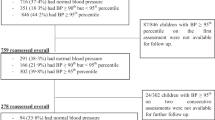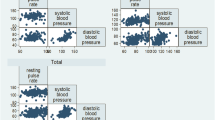Abstract
Epidemiological studies indicate that elevated blood pressure (BP) is common among children. Early detection of elevated BP in children is important in the prevention of cardiovascular disease (CVD). Difficulties exist in the diagnosis of “elevated” BP in children of 8–12 years of age. Normative tables of sex, age, and height specific BP percentile levels are required. Reports provide normative tables of BP percentile levels in children. Elevated BP is defined as systolic and diastolic BP ≥ 90th age, sex, and height specific BP percentile. The study tests the internal consistency and reliability between the normative tables of BP in children. The main objective of the study is to assess the reliability of existing normative tables of BP in children by using ad hoc analysis of a prior survey. A cross-sectional survey was performed in elementary school children (8–12 years of age, n = 818) from Istanbul, Turkey. The survey was conducted in 2007–2008. Four different normative tables of BP were used to determine children with elevated BP. The reliability and internal consistency between the normative tables of BP in children were assessed. The prevalences of elevated systolic and diastolic BP in children differed significantly between the normative tables of BP. The internal consistency between the normative tables was poor (Cronbach α coefficient = 0.429). Kuder–Richardson 21 test indicated poor reliability between the local and international normative tables of BP. In conclusion, the study indicates that there are significant inconsistencies and poor reliability between the national and international normative tables of BP in children.
This is a preview of subscription content, access via your institution
Access options
Subscribe to this journal
Receive 12 digital issues and online access to articles
$119.00 per year
only $9.92 per issue
Buy this article
- Purchase on Springer Link
- Instant access to full article PDF
Prices may be subject to local taxes which are calculated during checkout

Similar content being viewed by others
References
Agirbasli M, Tanrikulu AM, Berenson GS. Metabolic syndrome: bridging the gap from childhood to adulthood. Cardiovasc Ther. 2016;34:30–36.
Berenson GS, Srinivasan SR, Bao W, Newman WP III, Tracy RE, Wattigney WA. Association between multiple cardiovascular risk factors and the early development of atherosclerosis. Bogalusa Heart Study. N Engl J Med. 1998;338:1650–6.
Juhola J, Magnussen CG, Viikari JS, Kahönen M, Hutri-Kahönen N, Jula A, et al. Tracking of serum lipid levels, blood pressure, and body mass index from childhood to adulthood: the Cardiovascular Risk in Young Finns Study. J Pediatr. 2011;159:584–90.
Rosner B, Prineas RJ, Loggie JM, Daniels SR. Blood pressure nomograms for children and adolescents, by height, sex, and age, in the United States. J Pediatr. 1993;123:871–86.
National Elevated Blood Pressure Education Program Working Group on Elevated Blood Pressure in Children and Adolescents. The fourth report on the diagnosis, evaluation, and treatment of elevated blood pressure in children and adolescents. Pediatrics. 2004;114:555–7.
Flynn JT, Kaelber DC, Baker-Smith CM, Blowey D, Carroll AE, Daniels SR, et al. Clinical practice guideline for screening and management of elevated blood pressure in children and adolescents. Pediatrics. 2017;14:e20171904.
National Elevated Blood Pressure Education Program Working Group on Hypertension Control in Children and Adolescents. Update on the 1987 task force report on elevated blood pressure in children and adolescents: a working group report from the National Elevated Blood Pressure Education Program. Pediatrics. 1996;8:649–58.
Agirbasli M, Tanrikulu B, Arikan S, İzci E, Ozguven S, Besimoglu B, et al. Trends in body mass index, blood pressure and parental smoking habits in middle socio-economic level Turkish adolescents. J Hum Hypertens. 2008;22:12–17.
Agirbasli M, Adabag S, Ciliv G. Secular trends of blood pressure, body mass index, lipids and fasting glucose among children and adolescents in Turkey. Clin Obes. 2011;1:161–7.
Borici S, Agaoglu NB, Baykan OA, Agirbasli M. Blood pressure and anthropometric measurements in Albanian versus Turkish children and adolescents. Acta Cardiol. 2009;64:747–54.
Neuhauser HK, Thamm M, Ellert U, Hense HW, Rosario AS. Blood pressure percentiles by age and height from nonoverweight children and adolescents in Germany. Pediatrics. 2011;127:e978–88.
Cheung EL, Bell CS, Samuel JP, Poffenbarger T, Redwine KM, Samuels JA. Race and obesity in adolescent hypertension. Pediatrics. 2017;139:e20161433.
Lu Q, Ma CM, Yin FZ, Liu BW, Lou DH, Liu XL. How to simplify the diagnostic criteria of hypertension in adolescents. J Hum Hypertens. 2011;25:159–63.
Kelishadi R, Heshmat R, Ardalan G, Qorbani M, Taslimi M, Poursafa P, et al. First report on simplified diagnostic criteria for pre-hypertension and hypertension in a national sample of adolescents from the Middle East and North Africa: the CASPIAN-III study. J Pediatr. 2014;90:85–91.
Ozanli İ, Tülpar S, Yilmaz Y, Yildiz F. Blood pressure percentiles for school children. Dicle Med J. 2016;43:193–8.
Tümer N, Yalçinkaya F, İnce E, Ekim M, Köse K, Cakar N, et al. Blood pressure nomograms for children and adolescents in Turkey. Pediatr Nephrol. 1999;13:438–43.
Agirbasli M, Agaoglu NB, Ergonul O, Yagmur İ, Aydogar H, Oneri T, et al. Comparison of anthropometric indices in predicting metabolic syndrome components in children. Metab Syndr Relat Disord. 2011;9:453–9.
Fryar CD, Gu Q, Ogden CL, Flegal KM. Anthropometric reference data for children and adults: United States, 2011–2014. National Center for Health Statistics. Vital Health Stat. 2016;3:1–46.
Cole TJ, Bellizzi MC, Flegal KM, Dietz WM. Establishing a standard definition for child overweight and obesity worldwide: international survey. Br Med J. 2000;320:1240–3.
Chiolero A, Cachat F, Burnier M, Paccaud F, Bovet P. Prevalence of hypertension in schoolchildren based on repeated measurements and association with overweight. J Hypertens. 2007;25:2209–17.
Binka E, Brady TM. Real-world strategies to treat hypertension associated with pediatric obesity. Curr Hypertens Rep. 2019;21:18. https://doi.org/10.1007/s11906-019-0922-2. 12
Al Kibria GM, Swasey K, Sharmeen A, Day B. Estimated change in prevalence and trends of childhood blood pressure levels in the united states after application of the 2017 AAP guideline. Prev Chronic Dis. 2019;16:E12.
Fallah Z, Djalalinia S, Qorbani M, Farzadfar F, Kelishadi R. A systematic review of studies on blood pressure in Iranian pediatric population: first report from the Middle East and North Africa. Iran J Pediatr. 2016;26:e4496.
Ma C, Liu Y, Liu X, Yin F, Lu Q. Comparison of different screening methods for hypertension in Han adolescents. Clin Pediatr. 2016;55:363–7.
Xi B, Bovet P, Hong YM, Zong X, Chiolero A, Kim HS, et al. Recent blood pressure trends in adolescents from China, Korea, Seychelles and the United States of America, 1997–2012. J Hypertens. 2016;34:1948–58.
Muntner P, He J, Cutler JA, Wildman RP, Whelton PK. Trends in blood pressure among children and adolescents. JAMA. 2004;291:2107–13.
Rosner B, Cook NR, Daniels S, Falkner B. Childhood blood pressure trends and risk factors for elevated blood pressure: the NHANES experience 1988–2008. Hypertension. 2013;62:247–54.
Author information
Authors and Affiliations
Corresponding author
Ethics declarations
Conflict of interest
The authors declare that they have no conflict of interest.
Additional information
Publisher’s note Springer Nature remains neutral with regard to jurisdictional claims in published maps and institutional affiliations.
Rights and permissions
About this article
Cite this article
Agirbasli, M., Dilek, H.F., Tatlisu, M.A. et al. Reliability of normative tables in assessing elevated blood pressure in children. J Hum Hypertens 34, 241–247 (2020). https://doi.org/10.1038/s41371-019-0290-z
Received:
Revised:
Accepted:
Published:
Issue Date:
DOI: https://doi.org/10.1038/s41371-019-0290-z



